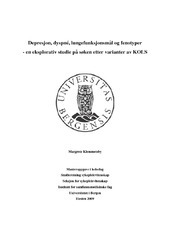| dc.contributor.author | Klemmetsby, Margrete | en_US |
| dc.date.accessioned | 2013-07-16T12:13:45Z | |
| dc.date.available | 2013-07-16T12:13:45Z | |
| dc.date.issued | 2009-11-16 | eng |
| dc.date.submitted | 2009-11-16 | eng |
| dc.identifier.uri | https://hdl.handle.net/1956/6819 | |
| dc.description.abstract | Dyspnoea and depression are among the novel symptoms in COPD patients, especially in severe stages of the disease. Knowledge on pulmonary function or phenotypic classifying of patients is limited concerning whether presence of lung hyperinflation will appear to be predicting dyspnoea and depression. Aim: Pulmonary function (forced expiratory volume in one second [FEV1] and inspiratory capacity [IC]) and phenotypes of hyperinflation (Dynamic and Static Hyperinflation) are investigated as predictors on dyspnoea and depression. Method: The study investigated 426 COPD patients in BergenCOPD study at including visit. Dyspnoea and depression were measured by Modified Medical Reaserch Council dyspnoea score (MMRC) and Centre for Epidemiological Studies Depression scale (CES-D) respectively. Pulmonary function was measured by Spirometry (FEV1) and body plethysmography (IC, TLC). Phenotypes of hyperinflation, static and both static and dynamic- hyperinflation were constructed on background of pulmonary function (IC%predicted and TLC%predicted). Results: Depression score >16 count twice as many among those with MMRC grade 3-4 opposed to grade 0-2. FEV1/TLC and FEV1% predicted are stronger and more consequent on predicting grade of dyspnoea than what IC, IC/TLC and IC% predicted are. Concerning dynamic hyperinflation" and static-dynamic hyperinflation" adjusted Odds ratio on having MMRC- dyspnoea grade 3-4 is 2,96 and 6,25 respectively opposed to no hyperinflation". Adjusted Odds ratio on having CES-D score > 16 is 2,66 when having dynamic hyperinflation" opposed to no hyperinflation". Conclusion: MMRC grade is explained by phenotypes of hyperinflation. Depression is clearly predicted better by MMRC dyspnoea grade than by pulmonary function and phenotypes of hyperinflation, and should be included as a tool concerning patient attendance. Patients should be screened for depression when having dyspnoea (MMRC grade 3-4). | en_US |
| dc.description.abstract | Sykdomsgrad vurdert ut fra lungefunksjon stemmer ikke alltid overens med grad av tungpust hos pasienter med kronisk obstruktiv lungesykdom (KOLS). Årsakene til tungpust er sammensatte, og det er begrenset viten om hvordan grad av hyperinflasjon påvirker grad av dyspné. Depresjon forekommer ofte hos KOLS-pasienter, og rapporteres ofte ved dyspné. Hensikt: Undersøke om lungefunksjon (forsert ekspiratorisk volum ved ett sekund [FEV1] og inspiratorisk kapasitet [IC]) og hyperinflasjonsfenotyper (dynamisk og statisk hyperinflasjon) kan predikere dyspné og depresjon. Metode: Studien undersøkte 426 KOLS-pasienter ved inklusjon i Bergen KOLS. Dyspné og depresjon ble målt med hhv Modified Medical Reaserch Council dyspneskår (MMRC) og Center for Epidemiological Studies Depression scale (CES-D). Lungefunksjon ble målt ved spirometri (FEV1) og bodypletysmografi (IC, TLC). Hyperinflasjonsfenotypene for dynamisk, statisk og kombinert statisk og dynamisk hyperinflasjon ble konstruert på bakgrunn av lungefunksjonsmål (IC%forventet og TLC%forventet). Resultat: Det var dobbelt så mange med depresjonsskår > 16 blant de med MMRC dyspnégrad 3-4 i forhold til grad 0-2. FEV1, FEV1/TLC og FEV1 % forventet var sterkere og mer konsekvente prediktorer for dyspné enn IC, IC/TLC og IC % forventet. For "dynamisk-hyperinflasjon" og "statisk-dynamisk-hyperinflasjon" var justert odds ratio for å ha MMRC-dyspnégrad 3-4 henholdsvis 2,96 og 6,25 i forhold til "ingen-hyperinflasjon." Justert odds ratio for å ha CES-D skår >16 var 2,66 for de med "dynamisk-hyperinflasjon" i forhold til "ingen-hyperinflasjon." Konklusjon: Hyperinflasjonsfenotypene forklarer MMRC(dyspnégrad). MMRC(dyspnégrad) predikerer depresjon klart bedre enn lungefunksjonsmålene og hyperinflasjonsfenotyper, og bør inkluderes som verktøy i forbindelse med pasientoppfølging. Ved dyspné (MRC-grad 3-4) bør pasientene undersøkes for depressive symptomer. | en_US |
| dc.format.extent | 365589 bytes | eng |
| dc.format.mimetype | application/pdf | eng |
| dc.language.iso | nob | eng |
| dc.publisher | The University of Bergen | eng |
| dc.subject | KOLS | eng |
| dc.subject | dyspné | eng |
| dc.subject | Depresjon | eng |
| dc.subject | hyperinflasjon | eng |
| dc.subject | fenotyper | eng |
| dc.subject | COPD | eng |
| dc.subject | dyspnoea | eng |
| dc.subject | Depression | eng |
| dc.subject | Hyperinflation | eng |
| dc.subject | phenotypes | eng |
| dc.subject.mesh | Depression | eng |
| dc.subject.mesh | Pulmonary Disease, Chronic Obstructive | eng |
| dc.title | Depresjon, dyspné, lungefunksjonsmål og fenotyper - en eksplorativ studie på søken etter varianter av KOLS | en_US |
| dc.type | Master thesis | |
| dc.rights.holder | Copyright the author. All rights reserved | |
| dc.description.degree | Master i Sykepleievitenskap | |
| dc.description.localcode | SYK395 | |
| dc.description.localcode | MAMD-SYK | |
| dc.subject.nus | 761901 | eng |
| fs.subjectcode | SYK395 | |
